July 9-11, 1999,
Alexis Park Resort, audience 400-500 people,
I am a document camera
Visual Vicarious Soliloquy
My becoming a document camera arose quite naturally
during some of the large number of invited lectures I was asked to
give. I'd typically use a video projector, and plug the projector into
my body, making the presentation from the computer attached to my body.
Most of my presentations I prepared as WWW pages, with links to my main
Web pages, so that giving a presentation was a simple act of showing
the audience a series of Web pages.
Now since I wear (or, in the more existential sense, ``am'')
an embodiment of my Wearable Wireless Webcam apparatus,
one of the Web pages I show to the audience is my
``Put yourself in my shoes and see the world from my perspective'' page.
I found that what for me seemed quite typical,
was shocking, or at least surprising to the audience, especially during
question and answer period when I would walk around in the audience,
and talk to people one--on--one, transmitting our conversation to the
projection television screen at the front.
However, perhaps the most useful outcome was of course the fact that I
could hold onto a small notepad, and look at the notepad, and of course the
whole audience could see the notepad as well. Often during presentations,
I would pace around the room, and walk out into the audience, and even sit
down in a chair, as if I were a member of the audience, while giving the
Keynote Address at a major conference or symposium.
Being me instead of seeing me
In many ways, I began to simply give lectures to myself, and transmit
these to the big screen at the front of the room.
Sometimes when giving a Keynote Address, I would leave the room while
I was giving the address --- giving the address to myself, so that the
audience could no longer see me. Of course the audience could still
hear me speaking, over the PA system which was responsive to an output
of my wearable apparatus, and of course the audience could still see
out through my right eye (or sometimes my left eye)
which was tapped, and transmitted to the large screen television.
Thus after a while, I began to wonder why I was actually physically
present at the conference site, particularly when the number of invitations
to give talks was growing. For a while, I was giving approximately three
Keynote Addresses a month, and this was indeed far too much needless travel.
Thus I came up with the idea that I'd do exactly the same thing as I had
always done, with one minute difference: I wasn't there.
Instead only my connection was there --- not my face, my avatar, or any
other aspect of me, except for the existential aspect of facilitation
by which the audience could vicariously be me:
being me rather than seeing me.
I called this style of lecture a ``Vicarious Soliloquy''.
It's not really a soliloquy, in the sense that it's not really
an audience watching, from an external viewpoint,
me give a talk to myself, but, rather the audience is vicariously
experiencing me give the talk to myself.
Example of Vicarious Soliloquy: DEFCON 7
An example of the Vicarious Soliloquy genre was my Keynote Address at
DEFCON~7.
(What is DEFCON~7?)
Perhaps it's incorrect to say ``I was invited to give the Keynote Address
at DEFCON~7''. Instead, it would be more correct to say that
``The audience of DEFCON~7 was invited to my Keynote Address'',
or maybe ``The audience of DEFCON~7 was invited to be my
soliloquy'' (as opposed to watching my soliloquy, as might be the case
in traditional cinematography in which the audience experiences a
second or third person viewpoint).
This excerpt from my reality stream depicts how the audience was, in effect,
able to be me, rather than see me,
in the sense that a first--person perspective was offered by the
apparatus of the invention serving as the existential document camera:




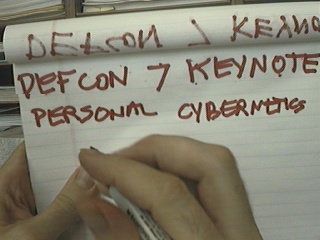

Downsampled frames taken from a
Vicarios Soliloquy motion picture sequence. Vicarious Soliloquy
is a new cinematographic genre characterized
by a true first--person perspective. Rather than see me,
I give the audience the opportunity to ``be me''. The existential
aspect of the apparatus of the invention puts the audience, in
effect, inside my head to share a first person perspective.
I presented the Keynote Address of DEFCON~7 as a lecture
to myself, which I gave while walking around, while writing on a
notepad. The apparatus of my invention causes the eye itself to,
in effect, function much like a document camera.
This capability adds a new dimension to videoconferencing.
In addition to writing on the notepad, I also looked at
(and therefore showed the audience) as well as annotated
copies of some of the historial pictures of the apparatus of my invention:
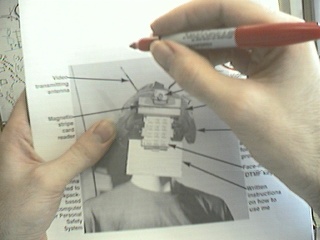
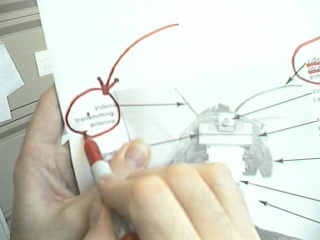
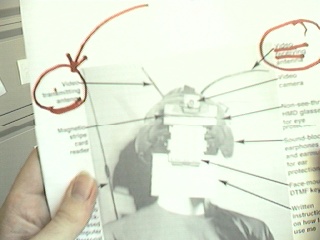
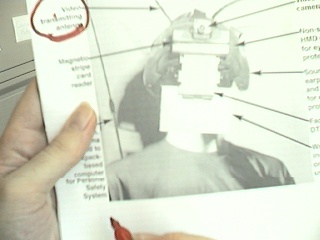
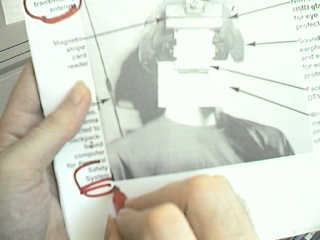
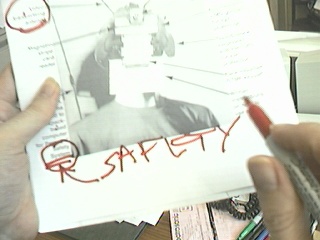
Looking at copies of a picture of an
historic WearComp apparatus, the audience also sees this same
video from my right eye.
Annotating copies of the picture,
I present a lecture to myself that others experience
vicariously.
Realitap: I am a luddite cyborg
During the Question and Answer period after my Keynote Address
at DEFCON~7 (July 1999), someone asked why I use paper, pens, and pencils
to give my lectures. I replied ``I'm a luddite'', to which the audience
responded with understanding laughter. I went on to explain how modern
technology has stolen away the humanistic aspects of our daily lives ---
such simple pleasures as the tactile feel of chalk, or pencil---on---paper.
I articulated my love of reality, (I don't like to watch TV or see movies ---
I prefer reality instead), and how I was simply sharing my love of reality,
through EyeTap.
See me or be me?
In conjunction with my DEFCON~7 Keynote, an audience member asked me
if I had a mirror I could look into (e.g. wondered what I looked like).
I found a beamsplitter (a transparent material with a thin optical
coating on it), which I held up in front of
myself, showing one of my older units that
I still often wear:


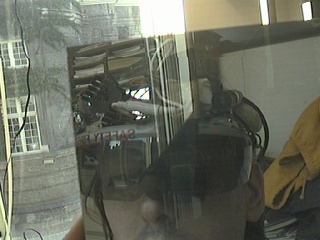
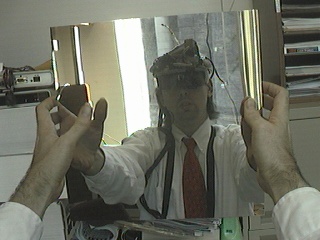
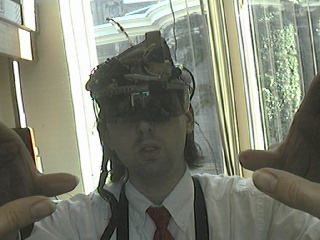
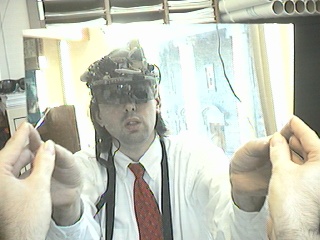
Not expecting to be seen by anyone, I wore one of my messy
old experimental rigs containing some parts more than 10 or 15 years
old. Having worn it so many years, it's become quite comfortable,
like an old pair of Levi's. But then someone in the audience asked
if I had a mirror, e.g. what did I look like.
I was able to find a beamsplitter with an aluminum coating,
which I held up in front of myself so that the audience could
both ``be me'' and see me at the same time.
What's needed to receive one of my Vicarious Soliloquy
For someone to receive a lecture that I present in the Vicarious
Soliloquy genre,
the setup is simple. Put three computers in a lecture hall.
Real computers! (No viruses, please.)
By that, I mean something like GNUX (GNU + Linux), along with
someone who's well versed in GNUX (e.g. so that I can remotely talk
to that person using various UNIX tools and that person will ``speak my
language'').
One computer goes to the big screen projector and runs a Web broswer that's
pointed to my right eye (e.g. visits my EyeTap site).
A second computer runs sfspeaker (SpeakFreely) and is connected to the PA
system, and is responsive to the microphone array of my apparatus.
A third computer runs sfmike and is set up so that I can hear the audience,
their reactions to my lecture, and such. The third system sends the
sound back to me, so that I can get audience feedback without
acoustic feedback
(e.g. I can hear the audience without getting the screech or squealing
sound of positive feedback run amok).
It's actually quite simple, for anyone with a reasonable degree of
UNIX competence, to facilitate such a talk and connection to my apparatus.

















